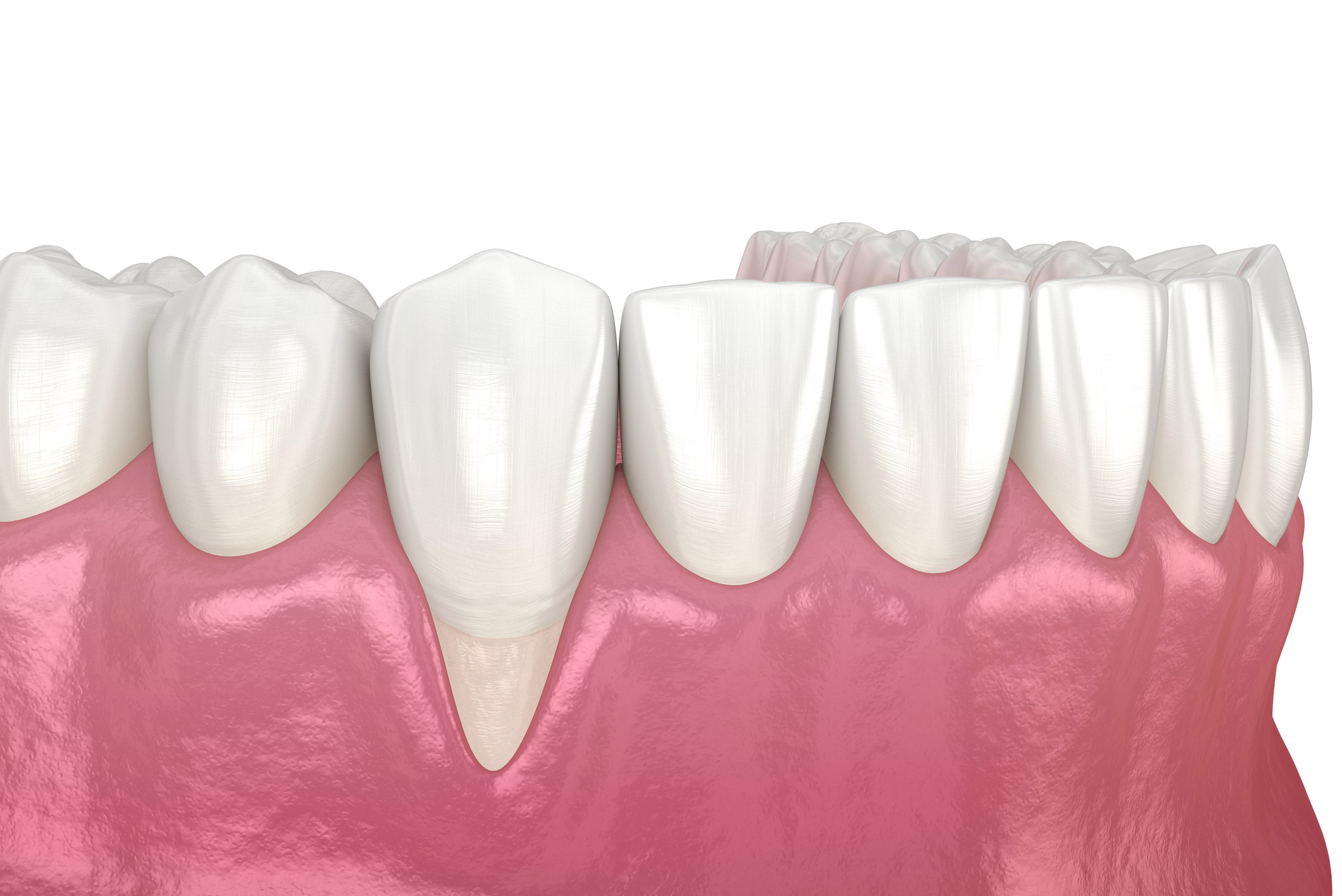Comprehensive
Dental Services
Whether your dental needs are a complete exam and cleaning, a full-mouth restoration, or anything in between, we promise to provide you with exceptional care as we enhance the natural beauty of your smile.
FAMILY
FAMILY APPOINTMENTS
Family – We have patients from birth to over 100 years old, so we are ready to take care of you no matter your age!
Landmark Dental has been part of the Sidney community for over 35 years. Our practice is honoured to have multi-generational families that see us regularly. It is not uncommon for grandmas, moms, and children of the same family, all have appointments the same day! Or cousins to run into each other in our reception area and meet for a big hug! Our greatest source of new patients is referrals from our existing patients, which is a testament to our commitment to our community and the level of care we provide.
Family Appointments: We know families are very busy and it can sometimes work better if everyone can get in for their dental care at the same time, on the same day. Our team includes four hygienists and two doctors working every day. We are often able to see the whole family at the same time!
BENEFITS OF HAVING A FAMILY DENTIST
A family dentist is a dental practice that treats patients of all ages and recognized their unique circumstances based on the phase of life they are in. There are several benefits to having a family dentist:
- Having a family dentist builds trust and reduces dental anxiety. Dental phobia and dental anxiety can result in delaying or avoiding dental care, leading to dental emergencies, infections, and tooth loss. Having a family dentist creates a trusting relationship for yourself and your family, therefore, reducing dental anxiety for everyone!
- Having a family dentist is convenient! It can help simplify your life by having everyone in the family visiting the same practice. We often schedule entire families at the same time or create a “dental date” for couples!
- A family dentist will notice and be able to monitor new conditions or symptoms between visits. This enables more conservative forms of treatment or allows the dentist to be proactive with treatment. Some dental conditions, for example, congenitally missing teeth, can be genetic. Being able to identify genetic conditions early can result in better outcomes for children and young adults.
- A family dentist can participate in keeping your family on schedule for regular care. Many times, when we remind patients that it has been 2 years since their last dental visit, they think it has only been 9 months – life is busy, and our team is here to help keep you on track!
We specialize in preventive care! Children’s teeth are in a sensitive developmental stage, teens’ and young adults’ habits change suddenly, and a new medication for a senior patient can create havoc with dry mouth. With regular dental visits, issues can be identified quickly, and the treatment is less invasive and less expensive.
When something happens, our team is here for you! We do our best to see all dental emergencies, however, our priority is to our existing patients. - We have relationships with all our dental specialists. If you require a referral to a dental specialist for anxiety, complex treatment, or other specialized care, you will benefit from the relationships we have built with them. With your permission, we will share important historical information, radiographs (x-rays), and our findings to help save you time and money at the Specialist.
DENTAL HEALTH FOR EVERY AGE
Infants: Primary teeth, commonly referred to as baby teeth, are susceptible to dental disease soon after eruption. We recommend that parents start to clean primary teeth regularly as soon as they erupt and watch for signs of plaque build-up, yellowing or darkness on the front surface of the teeth and the pits and fissures of the primary molars. If parents have any concerns about the appearance of their baby’s teeth, we are happy to see them.
Early Childhood: Children will keep some of their primary teeth until they are 12 – 13 years old so it is vital for the development of the permanent teeth and the health of the child to care and maintain primary teeth. We recommend that children start to visit us regularly (unless parents have any concerns) by 2 ½ – 3 years of age. Our goal at these early visits is to introduce the child to basic dental care, help reinforce at-home dental care habits, and identify and/or prevent any tooth or gum disease. We always do our best to make these happy visits and we have a treasure chest of prizes for children to choose from and each child gets to take home their sunglasses used during the visit!
Occasionally, we assess a child’s needs and determine they would have a better experience with a specialist, we have a close relationship with several pediatric dentists in the area who would be happy to see your little one.
Teens and Young Adults: Teens and Young adults require continued regular dental care as they enter a stage in their lives where diet, homecare, and growth/development can change significantly. We also get to contend with the development and eruption of wisdom teeth. Through regular dental care, we can continue to monitor and treat tooth and gum disease, identify teeth that need to be straightened or repositioned by orthodontics, and offer encouragement and support of dietary concerns and home-care habits. We also help educate teens and young adults about the oral effects of vaping and tobacco products.
Geriatric Dentistry: As a dental practice in Sidney for over 35 years, we are well-versed in the care of patients nearing and through their retirement years. Through better preventive care and people emphasizing the desire to keep their teeth, it is much more common to see our 65-year-old patients wearing Invisalign instead of dentures! Our seniors also are focused on having brighter, whiter, and more pleasing smiles!
Properly assessing and providing care for our more mature patients include:
- develop short- and long-term treatment plans that fit the changing status of dental benefits near retirement and other financial considerations
- Assessing medical health information and prescribed medication implications on oral health. Many prescription drugs cause dry mouth (xerostomia) and increase the incidents of cavities and accelerate periodontal disease and tooth loss
- educating patients about the link between periodontal disease and systemic diseases like heart disease, diabetes, and dementia
PREVENTIVE
DENTAL HYGIENE SERVICES
Our team of dental hygienists at Landmark Dental Centre is committed to providing extensive periodontal therapy for our patients to help ensure a healthy smile for a lifetime!
PERIODONTAL SCALING & ROOT PLANING
The objective of scaling and root planning is to remove calculus (tartar) which causes inflammation to the gingival (gum) tissue and surrounding bone.
These non-surgical procedures which completely cleanse the periodontium, work very effectively for individuals suffering from gingivitis (mild gum inflammation) and moderate/severe periodontal disease.
Why is periodontal scaling and root planning necessary?
Disease prevention – The oral bacteria which cause periodontal infections can travel via the bloodstream to other parts of the body. Research has shown that lung infections and heart disease have been linked to periodontal bacteria. Scaling and root planing remove bacteria and halts periodontal disease from progressing, thus preventing the bacteria from traveling to other parts of the body.
What do scaling and root planning treatments involve?
Scaling and root planing treatments are only performed after a thorough examination of the mouth. We will take X-rays, conduct visual examinations, and make a diagnosis before recommending or beginning these procedures.
Scaling – This procedure is usually performed with special dental instruments and may include an ultrasonic scaling tool. The scaling tool removes calculus and plaque from the surface of the crown and root surfaces. In many cases, the scaling tool includes an irrigation process that helps reduce bacteria below the gums.
Root Planing – This procedure is a specific treatment that serves to remove cementum and surface dentin that is embedded with unwanted microorganisms, toxins, and tartar. The root of the tooth is literally smoothed to promote good healing. Having clean, smooth root surfaces helps prevent bacteria from easily colonizing in the future.
During the next appointment, the hygienist will thoroughly examine the gums again to see how well the pockets have healed. If the gum pockets still measure deeper than healthy pocket depths, additional and more intensive treatments may be recommended or a referral to one of our network of Periodontists (gum specialists) may be required.
FLUORIDE TREATMENT
Fluoride is the most effective agent available to help prevent tooth decay. It is a mineral that is naturally present in varying amounts in almost all foods and water supplies. The benefits of fluoride have been well known and are supported by many health and professional organizations.
Topical fluoride strengthens teeth by absorbing into the outer surfaces of the tooth, making the teeth and exposed root surfaces more resistant to decay. We gain topical fluoride by using fluoride-containing dental products such as toothpaste, mouth rinses, and varnishes. Dentists and dental hygienists generally recommend that patients have a professional application of fluoride twice a year during dental hygiene visits.
Do I need a fluoride treatment?
Your dentist or dental hygienist may recommend the use of professional fluoride treatments for the following reasons:
- Deep pits and fissures on the chewing surfaces of teeth
- Exposed and sensitive root surfaces
- Fair to poor oral hygiene habits
- Frequent sugar and carbohydrate intake
- Inadequate saliva flow due to medical conditions, medical treatments, or medications
- Recent history of dental decay
Can fluoride help with sensitive teeth?
Yes, fluoride can help. A fluoride varnish absorbs into the tooth structure and hardens the enamel to prevent pain and sensitivity triggered by cold, sweet, or sour foods.
Stages of periodontal Disease
Do you have any bleeding when brushing and/or flossing your teeth? You could have the first stage of periodontal disease – gingivitis.
Gingivitis
- Gingivitis is a build-up of bacteria that causes localized areas of inflammation.
- In its early stages, inflammation around the gums is observable, with gum tissues appearing red and swollen.
- Gums that are easily irritated or that bleed during brushing and/or flossing indicate the presence of gingivitis.
Our team of dental hygienists will remove the plaque buildup which is necessary to prevent the further development of gum disease.
Early Periodontitis
- As the gums become more inflamed, they start to pull away from the teeth, forming spaces known as periodontal “pockets.”
- Food, bacteria, and plaque begin to collect in the pockets, leading to infection. The surrounding bone becomes damaged both by bacterial toxins and by the immune system’s response to infection.
- A periodontal examination includes using a periodontal probe to measure the pocket depths around each tooth identifying teeth that are at the early stage of periodontitis.
Our team of dental hygienists will customize a hygiene program to treat infected areas more frequently.
Moderate Periodontitis
- The symptoms of periodontitis become more severe as inflammation spreads, and some discomfort may occur.
- More supporting bone is lost, teeth loosen, and the gums recede further.
Advanced Periodontitis
- A major cause of tooth loss in adults, advanced periodontitis is marked by painful abscesses that are the result of the infection spreading beneath the gums.
SEALANTS AND SPLINTS
SEALANTS
A sealant is a thin, plastic coating applied to the chewing surface of molars, premolars and any deep grooves (called pits and fissures) of teeth. More than 75% of dental decay begins in these deep grooves. Teeth with these conditions are hard to clean and are very susceptible to decay. A sealant protects the tooth by sealing deep grooves, creating a smooth, easy-to-clean surface.
Sealants can protect teeth from decay for many years but need to be checked for wear and chipping at regular dental visits.
Reasons for sealants:
- Children and teenagers – As soon as the six-year molars (the first permanent back teeth) appear or any time throughout the cavity prone years of 6-16.
- Adults – Tooth surfaces without decay that have deep grooves or depressions.
- Baby teeth – Occasionally done if teeth have deep grooves or depressions and child is cavity prone.
What do sealants involve?
Sealants are applied by our one of our dental assistants or hygienists and the process takes only a couple of minutes per tooth.
The teeth to be sealed are thoroughly cleaned and then isolated with cotton to keep the area dry. A special solution is applied to the enamel surface to help the sealant bond to the teeth. The teeth are then rinsed and dried. Sealant material is carefully painted onto the enamel surface to cover the deep grooves or depressions. The material then cures with a special light.
SPLINTS/NIGHTGUARDS
BRUXISM
If you find yourself clenching your jaw throughout the day, or you wake up with sensitive teeth, a sore jaw, or a headache, you might suffer from bruxism.
Bruxism refers to an oral parafunctional activity which occurs in most of us at some point in our lives. The grinding of the teeth and the clenching of the jaw are the two main characteristics of this condition, which can occur either during the day or at night.
Bruxism is one of the most common sleep disorders and causes most of its damage during sleeping hours. The clenching and grinding which accompanies bruxism is symptomatic of a malfunctioning chewing reflex, which is usually turned off when sleeping. For people who are bruxing, deep sleep or even naps, cause the reflex nerve control center in the brain to turn off, and the reflex pathways to become active.
Earache, depression, headaches, eating disorders and anxiety are amongst the most common symptoms of bruxism.
Main reasons why bruxism should be promptly treated:
- Gum recession and tooth loss – Bruxism is one of the leading causes of gum recession and tooth loss; firstly, because it damages the soft tissue directly, and secondly because it leads to loose teeth and deep pockets where bacteria can colonize and destroy the supporting bone.
- Occlusal trauma – The abnormal wear patterns on the occlusal (chewing) surfaces can lead to fractures in the teeth, which may require restorative treatment.
- Myofascial pain – The grinding associated with bruxism can eventually shorten and blunt the teeth. This can lead to muscle pain in the myofascial region and debilitating headaches.
- Arthritis – In severe and chronic cases, bruxing can eventually lead to painful arthritis in the temporomandibular (TMJ) joint.
Treatment Options for Bruxism:
There is no single cure for bruxism, though a variety of helpful treatment options are available. Some common ways in which bruxism is treated include:
- Nightguards/Splints – An acrylic mouthguard can be designed from digital scans using our Itero to minimize the abrasive action of tooth surfaces during normal sleep. Mouthguards should be worn on a long-term basis to help prevent tooth damage, damage to the temporomandibular joint and help to stabilize the occlusion.
- NTI Appliance – This device is fitted by the dentist and only covers the front teeth. It is worn intermittently on a schedule to help retrain the temporalis muscle.
RESTORATIVE
RESTORATIONS
Webster’s Definition: to bring back to or put back into a former or original state.
In dentistry, we restore tooth structure using a variety of materials and procedures to bring teeth back to their original state.
We use tooth coloured restorations (bonding) to repair teeth that have:
- Decay or cavities
- Small fracture lines and breaks
- Excessive wear
- Gaps or spaces between teeth
- Esthetic problems
Not all restoration materials are the same. Landmark Dental Centre works with the latest materials and techniques to provide premier restorations for our patients.
LANDMARK DENTAL CENTRE is a proud PARTNER with BIOCLEAR ![]()
CROWNS
Webster’s Definition: a reward of victory or mark of honor; an artificial substitute for the part of the tooth external to the gum.
We use crowns to restore teeth that have:
- Decayed, broken, or fractured teeth that cannot be restored with a filling
- Structural or cosmetic restoration of smile teeth
- Large, old fillings that need to be replaced
- Root canal treated teeth
A crown covers the part of the tooth that you see and protects it from future damage or fracture. Our affiliated lab technicians work hard to make sure the crown is fabricated to your tooth’s original size and shape. We work with you to choose the crown material which works best for your tooth based on strength of material, esthetic concerns, and your preferences.
No more IMPRESSIONS – no goop, no gagging
In most cases, our dentists can use our Itero scanner to digitally record the preparation of the prepared tooth and share that information with our dental lab electronically. No trays and no impression material.
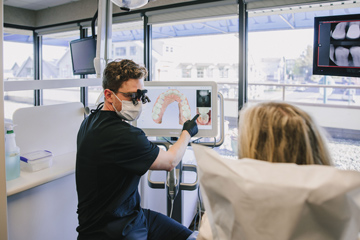
BRIDGES
Webster’s Definition: a structure carrying a pathway or roadway over a depression or obstacle (such as a river); a dental bridge is a fixed prosthesis that uses two anchoring teeth on either side of a space made by a missing or extracted tooth, to replace the missing tooth.
Bridges:
- Replace or fill the space of a missing/extracted tooth
- Help keep your cheek and overall face shape after you lose a tooth
- Prevent remaining teeth from drifting out of position and damaging your bite
- Restore your ability to chew and therefore maintains good digestive health
- Restore your smile
- Can be used to replace removable partial dentures
- Bridges are one option for replacing a missing tooth (or teeth) when the teeth that are anchoring the bridge need restoration as well.
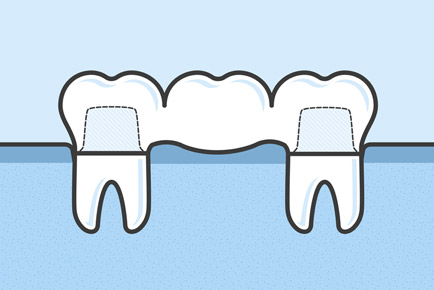
No more IMPRESSIONS – no goop, no gagging
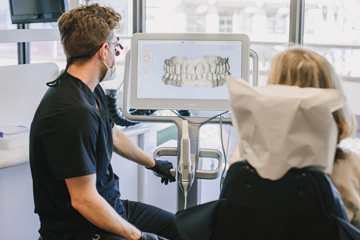
In most cases, our dentists can use our Itero scanner to digitally record the preparation of the prepared tooth and share that information with our dental lab electronically. No trays and no impression material.
Implant placement and restoration
What are dental implants?
A dental implant is a root-shaped titanium fixture used to support one or more missing teeth. Dental implants may be used to replace single or multiple missing teeth or assist in the retention and comfort of removable dentures, improving chewing function.
Dental implants are just as secure and durable as your natural teeth. The longevity of dental implants easily outlasts things like dentures or bridges.
Advantages of dental implants:
- Replace one or more missing teeth without affecting adjacent teeth.
- Restore a patient’s smile.
- Restore chewing, speech, and digestion.
- Support a bridge or denture, making them more secure and comfortable.
What is getting a dental implant?
The process of getting dental implants requires a few visits over several months. Records are taken of the jaw and teeth to determine bone, gum tissue, and spacing available for an implant(s). The implant(s) will be surgically placed into the bone and allowed to heal and integrate itself onto the bone for up to six months. Once the implant(s) has integrated with the bone, the final restoration is fabricated to custom fit the implant. If it is a single tooth, a crown is fabricated.
Good oral hygiene, eating habits, and regular dental visits will aid in the life of your new implant.
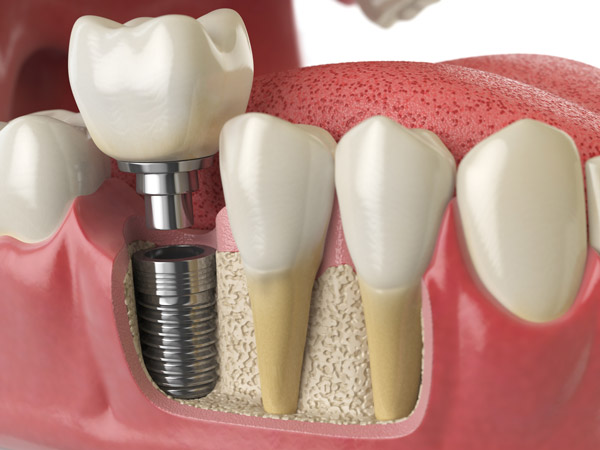
Additional
INVISALIGN

HOW DOES INVISALIGN TREATMENT WORK?
Invisalign® clear aligners use the most advanced technology to give you your best smile.
SmartTrack material can straighten your teeth with more predictability. Plus, your smile is
shaped more comfortably than with traditional braces.
Invisalign® offers an almost invisible aligning system that straightens teeth fast and
contains no metal.
Invisalign® treatment consists of a series of custom-made aligning trays. The dentist
changes the trays every several weeks to fit the new tooth configuration. In addition to the
reduced visual impact, Invisalign® aligning trays can be temporarily removed for important
occasions – meaning that treatment duration is patient-controlled.
THE TREATMENT
A complete Itero® scan is used to craft a complete digital treatment plan, mapping out your
best smile from beginning to end. The ClinCheck is reviewed and approved by you prior to
treatment.
THE ALIGNERS
Invisalign clear aligners are designed to transform your smile and are made with unique
advances, such as SmartTrack material for comfort and predictability. Each aligner
throughout your treatment gradually and predictably moves your teeth as you continue
with your day-to-day activities.

Whitening
Teeth whitening is the most non-invasive, conservative way to brighten your smile! We fabricate custom-fitting whitening trays and use ZOOM Day Whitening in a take-home system that is known to dramatically whiten teeth.
It’s important to note that teeth whitening only works on natural tooth enamel, so make sure to have your teeth examined before starting any whitening systems. Restorative/Filling material and porcelain crowns are unaffected by whitening solutions. Please contact us to book an evaluation to find out if whitening is a good option for you!
Gum grafting
Some people develop a condition called gum recession. This is when the root of the tooth is exposed and the gum tissue migrates down the root of the tooth. When left untreated the exposed roots and bone can become sensitive and is likely to decay. In more severe cases, bone loss can lead to the loss of a tooth.
A gum graft can prevent or reverse these adverse effects and restore your gums to good health.
What is a gum graft?
Gum grafting involves taking a piece of tissue from a site within the mouth and attaching it to where the gum tissue has receded. It uses healthy tissue already in your mouth to correct and protect the rest of your smile against further complications.
